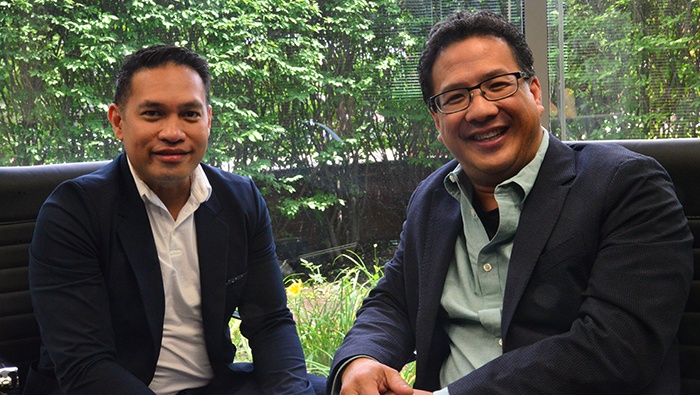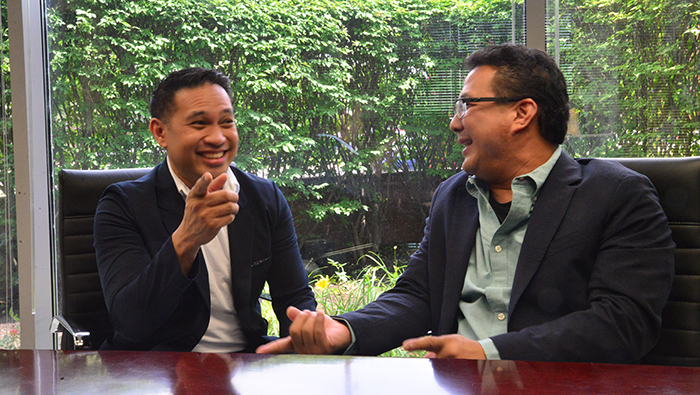An interview with Carlos Manalo (Co-Founder at The Office of Experience) and Gavin Lew (Managing Director, Bold Insight).
What is the history with Bold Insight and The Office of Experience?
 Gavin: Over the last few years, the impact of user experience (UX) on an organization’s brand has finally become clear to our clients. We knew that the same organizations undergoing digital transformation and brand evolution would be best served underpinning this evolution with user research and a unique blend of design agency and innovation strategy experts. Because of this, one of the first things I did when we started Bold Insight was call Carlos at The Office of Experience (OX) to forge a strategic partnership.
Gavin: Over the last few years, the impact of user experience (UX) on an organization’s brand has finally become clear to our clients. We knew that the same organizations undergoing digital transformation and brand evolution would be best served underpinning this evolution with user research and a unique blend of design agency and innovation strategy experts. Because of this, one of the first things I did when we started Bold Insight was call Carlos at The Office of Experience (OX) to forge a strategic partnership.
We have worked together in various capacities for more than 10 years, whether on client side or consultancy, we’ve worked on everything from ecommerce (both online and in-store) to digital transformations within non-profit organizations. The first time I saw an output of OX – what they deliver to the C-suite – I was impressed. It was not only gorgeous, but it was rooted in user-centered design thinking. Many companies say they do design thinking, but what I saw what OX produced, I really saw how the outputs of design thinking can really move the needle. They have a specialty that UX teams typically don’t have. I knew that creating a partnership with them would benefit our clients and theirs.
Carlos: The reason why we succeed at the C-suite is not because we have some magic magnet, rather we start the conversation, we ask two fundamental questions: (1) what problem are you trying to solve? (trying to get to root cause analysis) and, concurrent to that, (2) what story are you trying to tell? That, to us, are the two pathways to uncover what we are trying to design. We believe that you cannot design what you do not understand. To move forward, make progress, and deliver on great design you must understand those two things.
Our relationship really started years ago, working jointly on a project for Allen Edmonds. It started as a website redesign, which led to campaign, catalogue, product and store concepting and, ultimately, rebranding. Because of the work we did, and delivering on what we pitched, management internalized being user-centered; it’s part of their culture now. This is what we founded OX on – rooted in user-centered thinking.
How do Bold Insight and OX seamlessly intersect from a client perspective?
Carlos: Where it really pays out, when it’s most successful is when we have mature research to ground our hypotheses and the instinct to move everything forward given the empirical inputs that we pull from these data points.
Gavin: And that’s where Bold Insight is the tip of the spear. To guide, not only instincts, but it gets to the heart of design insight. One of the challenges I have always had with design thinking is that anyone can do it if they just “empathize with the user.” The bad narrative is that design thinking has become an excuse to just do the same thing you’ve always done but now with a hot label. Real design thinking must put evidence (data) behind the design. Too many ‘immerse” themselves in the user experience but they use more instinct than evidence to fuel the development from ideation to iterative design. That’s where we differentiate–uncovering the evidence that helps to shape the design. We want to empower designers to do more than provide empathy but allow them to design with confidence.
Carlos: Fundamentally, I agree with that. What is service design? It’s uncovering the customer journey and making sure we understand from a systems, tools, processes, brand propositions standpoint that all of those things have a throughline and that we are delivering the first principles, the moments of wonder, and then making sure we are calibrating and adjusting the failure points. Today, that is the brand experience. If your service-design model is not rooted in understanding what your brand is, and what you need to do to deliver on that, you aren’t going to make a lot of progress.
What we are doing is finding out the core values of an organization and the brand story they want to impart. Then manifest what they are trying to do whether it be a website, internal communications, or rebranding a 100 year old company as they get ready for the next 100 years…that is what we do.
How have the UX and brand industries evolved to be so intertwined?
Carlos: The reality is, The Experience is the Brand™ today. If you don’t understand that as a practitioner, you are only going to fix 20% of the problems in any given opportunity space. As a C-suiter, if you don’t understand the value of UX, the true user experience – we aren’t talking about wireframes, site maps, and flows, we’re talking about how the brand shows up for your organization as they interact and engage with employees, business partners, supply chain, and, at the end of it, the end customer – then you’re missing the boat.
Boiling it down, organizations ask, “are we delivering on our brand promise?” and “are the experiences customers walking away with, the ones we said they were going to get?”
How does this partnership uniquely fill the gap in digital transformation that companies are making?
Carlos: At the end of the day, with a great hypothesis vetted and validated by the scientific method and making sure that we have the customer empathy portion of this correct, we can’t deliver what we want to deliver for organizations without a great research partner like Bold Insight. And, conversely, Bold Insight cannot deliver the promise and the impact of research without someone chartering the path to brand delivery.
Gavin: There is a back and forth to do our best to capture what it is when an executive says, “I want ‘x’”. OX can create and shape and our research ensures that the brand experience hits the mark.
Carlos: And it’s not just about developing a plan and executing against it. Those years are gone. In our world, brands are always shifting. The brand must constantly evolve and iterate. The principles can stay the same, but the expression system by which the brand manifests, that is malleable, and it should be. So our job as brand stewards is to have the ability to adjust and amplify. Again, without a foundation of great research, we won’t know the rails by which we do this.
Gavin: Otherwise, you are just guessing. And I think as designers we need to be honest about our abilities—intuition and a design sense can only take one so far. To have the humility to recognize that your creativity can be so much better if it is part of a process in which research feeds the design—those are elements that endure.


